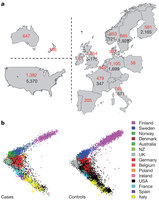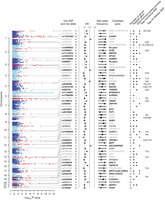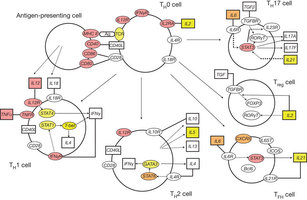摘要:一个国际科学家团队10日报告说,他们新发现了29个与多发性硬化症有关的基因,将有助于增进对这一中枢神经系统疾病的理解。
科学家们研究了近1万名发性硬化症患者以及1.7万名健康人的脱氧核糖核酸,确认了23个此前已知与多发性硬化症有关的基因,并发现了29个与此疾病相关的新基因。
参与此次研究的美国范德比尔特大学人类基因研究中心主任乔纳森·海恩说,新发现的关联基因显示了多发性硬化症的复杂性,并提供了研究其发病机理的新线索。
多发性硬化症患者自身免疫细胞会错误攻击神经元髓鞘,造成患者出现视觉障碍、肌肉无力等症状。美国国家多发性硬化症协会数据显示,全球约有210万名发性硬化症患者。
此次的研究论文10日发表在英国《自然》杂志上。ssss

Scientists have identified 29 new genetic variants linked to multiple sclerosis, providing key insights into the biology of a very debilitating neurological disease. Many of the genes ¬implicated in the study are relevant to the immune system, shedding light onto the immunological pathways that underlie the development of multiple sclerosis.
生物探索推荐英文论文摘要:
Nature 476, 214–219 (11 August 2011)
Doi:10.1038/nature10251
Genetic risk and a primary role for cell-mediated immune mechanisms in multiple sclerosis
Multiple sclerosis is a common disease of the central nervous system in which the interplay between inflammatory and neurodegenerative processes typically results in intermittent neurological disturbance followed by progressive accumulation of disability. Epidemiological studies have shown that genetic factors are primarily responsible for the substantially increased frequency of the disease seen in the relatives of affected individuals, and systematic attempts to identify linkage in multiplex families have confirmed that variation within the major histocompatibility complex (MHC) exerts the greatest individual effect on risk. Modestly powered genome-wide association studies (GWAS) have enabled more than 20 additional risk loci to be identified and have shown that multiple variants exerting modest individual effects have a key role in disease susceptibility. Most of the genetic architecture underlying susceptibility to the disease remains to be defined and is anticipated to require the analysis of sample sizes that are beyond the numbers currently available to individual research groups. In a collaborative GWAS involving 9,772 cases of European descent collected by 23 research groups working in 15 different countries, we have replicated almost all of the previously suggested associations and identified at least a further 29 novel susceptibility loci. Within the MHC we have refined the identity of the HLA-DRB1 risk alleles and confirmed that variation in the HLA-A gene underlies the independent protective effect attributable to the class I region. Immunologically relevant genes are significantly overrepresented among those mapping close to the identified loci and particularly implicate T-helper-cell differentiation in the pathogenesis of multiple sclerosis.

Figure 1: Distribution of cases and controls.

Figure 2: Regions of the genome showing association to multiple sclerosis.

Figure 3: Graphic representation of the T-helper-cell differentiation pathway.
生物探索推荐英文论文摘要:
Multiple Sclerosis Research Doubles Number of Genes Associated With the Disease, Increasing the Number to Over 50
Dr. John Rioux, researcher at the Montreal Heart Institute, Associate Professor of Medicine at the Université de Montréal and original co-founder of the International Multiple Sclerosis Genetics Consortium is one of the scientists who have identified 29 new genetic variants linked to multiple sclerosis, providing key insights into the biology of a very debilitating neurological disease. Many of the genes implicated in the study are relevant to the immune system, shedding light onto the immunological pathways that underlie the development of multiple sclerosis.
The research, involving an international team of investigators led by the Universities of Cambridge and Oxford, and funded by the Wellcome Trust, was published August 10 in the journal Nature. This is the largest MS genetics study ever undertaken and includes contributions from almost 250 researchers as members of the International Multiple Sclerosis Genetics Consortium and the Wellcome Trust Case Control Consortium.
Multiple sclerosis is one of the most common neurological conditions among young adults, affecting around 2.5 million individuals worldwide. The disease results from damage to nerve fibres and their protective insulation, the myelin sheath, in the brain and spinal cord. The affected pathways -- responsible in health for everyday activities such as seeing, walking, feeling, thinking and controlling the bowel and bladder -- are prevented from 'firing' properly and eventually are destroyed. The new findings focus attention on the pivotal role of the immune system in causing the damage and help to explain the nature of the immune attack on the brain and spinal cord.
In this multi-population study, researchers studied the DNA from 9,772 individuals with multiple sclerosis and 17,376 unrelated healthy controls. They were able to confirm 23 previously known genetic associations and identified a further 29 new genetic variants (and an additional five that are strongly suspected) conferring susceptibility to the disease.
A large number of the genes implicated by these findings play pivotal roles in the workings of the immune system, specifically in the function of T-cells (one type of white blood cell responsible for mounting an immune response against foreign substances in the body but also involved in autoimmunity) as well as the activation of 'interleukins' (chemicals that ensure interactions between different types of immune cell). Interestingly, one third of the genes identified in this research have previously been implicated in playing a role in other autoimmune diseases (such as Crohn's Disease and Type 1 diabetes) indicating that, perhaps as expected, the same general processes occur in more than one type of autoimmune disease.
Previous research has suggested a link between Vitamin D deficiency and an increased risk of multiple sclerosis. Along with the many genes which play a direct role in the immune system, the researchers identified two involved in the metabolism of Vitamin D, providing additional insight into a possible link between genetic and environmental risk factors.
Dr. Alastair Compston from the University of Cambridge who, on behalf of the International Multiple Sclerosis Genetics Consortium, who led the study jointly with Dr. Peter Donnelly from the Wellcome Trust Centre for Human Genetics, University of Oxford, said: "Identifying the basis for genetic susceptibility to any medical condition provides reliable insights into the disease mechanisms. Our research settles a longstanding debate on what happens first in the complex sequence of events that leads to disability in multiple sclerosis. It is now clear that multiple sclerosis is primarily an immunological disease. This has important implications for future treatment strategies."
Dr. Donnelly added: "Our findings highlight the value of large genetic studies in uncovering key biological mechanisms underlying common human diseases. This would simply not have been possible without a large international network of collaborators, and the participation of many thousands of patients suffering from this debilitating disease."
Dr. John Rioux, holder of the Canada Research Chair in Genetics and Genomic Medicine, furthermore stated that "the integration of the genetic information emerging from studies of this and other chronic inflammatory diseases such as Crohn's disease, ulcerative colitis, arthritis and many others is revealing what is shared across these diseases and what is disease-specific. This is but one of the key bits of information emerging from these studies that will guide the research of disease biology for years to come and be the basis for the development of a more personalized approach to medicine."







